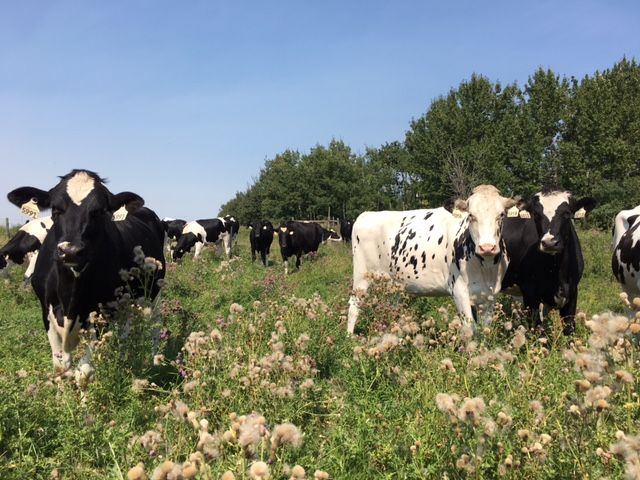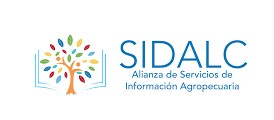Factores asociados a la liberación de gonadotrofinas y ovulación después de la administración exógena de GnRH en el Bos Taurus
DOI:
https://doi.org/10.19137/cienvet202224208Palabras clave:
Estrógeno, Progesterona, Liberación de LH, Dinámica folicular, Inseminación artificialResumen
La hormona liberadora de gonadotropina (GnRH) es un decapéptido, sintetizado por las neuronas GnRH en el hipotálamo, que estimula la síntesis y secreción de gonadotrofinas (hormonas folículo estimulante, FSH y luteinizante, LH) de la hipófisis anterior o adenohipofisis. Agonistas de GnRH con una estructura idéntica o similar a la natural han estado disponible comercialmente desde la década del 70 y han sido utilizadas en un principio para el tratamiento de quistes foliculares y el mejoramiento de la fertilidad en el ganado vacuno (1). La ovulación de folículos ováricos después de la administración de GnRH fue reportada por primera vez por Schams et al. (2) y Britt et al. (3), pero no fue hasta la década del 90 cuando la GnRH se comenzó a utilizar para controlar la dinámica folicular durante el ciclo estral del bovino. Ahora sabemos que una nueva onda folicular emerge dentro de los 2 días después de la ovulación del folículo dominante presente en el momento del tratamiento con GnRH (4,5). Este hallazgo facilitó el desarrollo de protocolos de sincronización a base de GnRH en combinación con prostaglandinas (PGF) que permiten la inseminación artificial a tiempo fijo (IATF), sin necesidad de realizar detección de celo. Estos protocolos a base de GnRH y PGF son parte del manejo reproductivo bovino, sobre todo del ganado lechero, en muchos rodeos comerciales del mundo. Existen numerosos protocolos a base de GnRH y PGF disponibles para la sincronización del estro y la ovulación en el ganado, varios de esos protocolos se han explicado y discutido en detalle en otros artículos (6,7). El objetivo de esta revisión es describir los factores asociados a la liberación de LH y respuesta ovulatoria posterior a la administración de GnRH, dar a conocer información relevante sobre el efecto de las hormonas esteroideas en la respuesta a la GnRH y, por último, brevemente postular estrategias que podrían mejorar la eficacia de los protocolos basados en la aplicación de GnRH y PGF
Descargas
Citas
2. Schams D, Hofer F, Hoffmann B, Ender M, Karg H. Effects of synthetic LH-RH treatment on bovine ovatian function during oestrous cycle and postpartum period. Acta Endocrinologica Suppl 1973: 177:296 (Abstr.).
3. Britt JH, Kittok RJ, Harrison DS. Ovulation, estrus and endocrine response after GnRH in early postpartum cows.J Anim Sci 1974; 39:915-919.
4. Twagiramungu H, Guilbault LA, Dufour JJ. Synchronization of ovarian follicular waves with a gonadotropin-releasing hormone agonist to increase the precision of estrus in cattle: A review. J Anim Sci 1995; 73:3141-3151.
5. Martínez MF, Adams GP, Bergfelt D, Kastelic JP, Mapletoft RJ. Effect of LH or GnRH on the dominant Follicle of the first follicular wave in heifers.Anim Reprod Sci 1999; 57:23-33.
6. Colazo MG and Mapletoft RJ. A review of current timed-AI (TAI) programs for beef and dairy cattle. Can Vet J 2014; 55:772-780.
7. Sanz A, Macmillan K, Colazo MG. Revisión de los programas de sincronización ovárica basados en el uso de hormona liberadora de gonadotropinas y prostaglandina F2α para novillas de leche y de carne. ITEA-Inf. Tec. Econ. Agrar. 2019; 115: 326-341.
8. Perrett RM and McArdle CA. Molecular mechanisms of gonadotropin-releasing hormone signaling: integrating cyclic nucleotides into the network. Front. Endocrinol 2013; 4:180. doi: 10.3389/fendo.2013.00180.
9. Kaltenbach CC, Dunn TG, Kiser TE, Corach LR, Akbar AM, Niswender GD. Release of FSH and LH in beef heifers by synthetic gonadotrophin releasing hormone. J Anim Sci 1974; 38:357-362.
10. Chenault JR, Kratzer DD, Rzepkowski RA, Goodwin MC. LH and FSH response of Holstein heifers to fertirelin acetate, gonadorelin and buserelin. Theriogenology 1990; 34: 81–98.
11. Martínez M, Mapletoft RJ, Kastelic JP, Carruthers T. The effects of 3 gonadorelin products on luteinizing hormone release, ovulation, and follicular wave emergence in cattle. Can Vet J 2003; 44:125-131.
12. Macmillan KL and Thatcher WW. Effects of an agonist of gonadotropin-releasing hormone on ovarian follicles in cattle. Biol Reprod 1991; 45:883-889.
13. Kesler D J; Elmore R G; Brown E M; Garverick H A. Gonadotropin releasing hormone treatment of dairy cows with ovarian cysts. I. Gross ovarian morphology and endocrinology. Theriogenology 1981;16: 207-217.
14. Moreira F, de la Sota RL, Diaz T, Thatcher WW. Effect of day of the estrous cycle at the initiation of a timed artificial insemination protocol on reproductive responses in dairy heifers. J Anim Sci 2000; 78:1568-1576.
15. Di Gregorio GB and Nett TM. Estradiol and progesterone influence the synthesis of gonadotropins in the absence of gonadotropin-releasing hormone in the ewe. Biol Reprod 1995; 53:166-172.
16. Colazo MG, Davis H, Rutledge MD, Kastelic JP, Martinez MF, Small JA, Mapletoft RJ. Effects of plasma progestwerone concentrations on LH release and ovulation in beef cattle given GnRH. Domest Anim Endocrinol 2008; 34:109-117.
17. Dias FCF, Colazo MG, Kastelic JP, Mapletoft RJ, Adams GP, Singh J. Progesterone concentration, estradiol pre-treatment, and dose of GnRH affect GnRH-mediated LH release in beef heifers. Domest Anim Endocrinol 2010; 39:155-162.
18. Xu ZZ, Garverick HA, Smith GW, Smith MF, Hamilton SA, Youngquist RS. Expression of follicle-stimulating hormone and luteinizing hormone receptor messenger ribonucleic acids in bovine follicles during the first follicular wave. Biol Reprod 1995; 53:951-957.21.
19. Pursley JR, Mee MO, Wiltbank MC. Synchronization of ovulation in dairy cows using PGF2α and GnRH. Theriogenology 1995; 44:915-923.
20. Schoenemann HM, Humphrey WD, Crowder ME, Nett TM, Reeves JJ. Pituitary luteinizing- hormone-releasing hormone receptors in ovariectomized cows after challenge with ovarian-steroids. Biol Reprod 1985; 32:574–583.
21. Nett TM, Turzillo AM, Baratta M, Rispoli LA. Pituitary effects of steroid hormones on secretion of follicle-stimulating hormone and luteinizing hormone. Domest Anim Endocrinol 2002; 23:33–42.
22. Baratta M, West LA, Turzillo AM, Nett TM. Activin modulates differential effects of estradiol on synthesis and secretion of follicle-stimulating hormone in ovine pituitary cells. Biol Reprod 2001; 64:714–719.
23. Small JA, Colazo MG, Kastelic JP, Mapletoft RJ. Effects of progesterone presynchronization and eCG on pregnancy rates to GnRH-based, timed-AI in beef cattle. Theriogenology 2009; 71:698-706.
24. Colazo MG, Gordon MB, Rajamahendran R, Mapletoft RJ, Ambrose DJ. Pregnancy rates to timed-AI in dairy cows treated with gonadotropin releasing hormone or porcine luteinizing hormone. Theriogenology 2009a; 72:262-270.
25. Colazo MG, Ambrose DJ. Neither duration of progesterone insert nor initial GnRH treatment affect pregnancy per timed-insemination in dairy heifers subjected to a Co-synch protocol. Theriogenology 2011; 76:578-588.
26. Colazo MG, Ponce-Barajas P, Ambrose DJ. Pregnancy per AI in lactating dairy cows subjected to two different intervals from presynchronization to initiation of Ovsynch protocol. J Dairy Sci 2013a; 96:7640-7648.
27. Colazo MG, Dourey A, Rajamahendran R, Ambrose DJ. Progesterone supplementation before timed AI increased ovulation synchrony and pregnancy per AI, and supplementation after timed AI reduced pregnancy losses in lactating dairy cows. Theriogenology 2013b; 79:833-841.
28. Dirandeh E, Rezaei Roodbari A, Gholizadeh M, Deldar H, Masoumi R, Kazemifard M, Colazo MG. Administration of prostaglandin F2α 14 d before initiating a G6G or a G7G timed artificial insemination protocol increased circulating progesterone prior to artificial insemination and reduced pregnancy loss in multiparous Holstein cows. J Dairy Sci 2015a; 98:5414-5421.
29. Dirandeh E, Rezaei Roodbari A, Colazo MG. Double-Ovsynch, compared to Presynch with or without GnRH, improves fertility in heat-stressed lactating dairy cows. Theriogenology 2015b; 83:438-443.6.
30. Colazo MG and Ambrose DJ. Effect of initial GnRH and duration of progesterone insert treatment on the fertility of lactating dairy cows. Reproduction Domestic Animal 2015; 50:497-504.
31. Zwiefelhofer EM, Macmillan K, Gobikrushanth M, Adams GP, Yang SX, Anzar M, Asai-Coakwell M, Colazo MG. Comparison of two intravaginal progesterone-releasing devices in shortened-timed artificial insemination protocols in beef cattle. Theriogenology 2021; 168: 75-82.
32. Picard-Hagen N, Lhermie G, Florentin S, Merle D, Freina P, Gayrard V. Effect of gonadorelin, lecirelin, and buserelin on LH surge, ovulation, and progesterone in cattle. Theriogenology 2015; 84:177–183.
33. Souza AH, Cunha AP, Silva EPB, Gumen A, Ayres H, Guenther JN, Wiltbank MC. Comparison of gonadorelin products in lactating dairy cows: Efficacy based on induction of ovulation of an accessory follicle and circulating luteinizing hormone profiles. Theriogenology 2009; 72:271–279.
34. Colazo MG, Ree T, Emmanuel DGV, Ambrose DJ. Plasma luteinizing hormone concentrations and luteal function in cows given repeated treatments or various doses of gonadotropin releasing hormone. Theriogenology 2009b; 71:984-992.
35. Fricke PM, Guenther JN, Wiltbank MC. Efficacy of decreasing the dose of GnRH used in a protocol for synchronization of ovulation and timed AI in lactating dairy cows. Theriogenology 1998; 50:1275–1284.
36. Giordano JO, Fricke PM, Guenther JN, Lopes Jr G, Herlihy MM, Nascimento AB, Wiltbank MC. Effect of progesterone on magnitude of the luteinizing hormone surge induced by two different doses of gonadotropin-releasing hormone in lactating dairy cows. J. Dairy Sci 2012; 95:3781–3793.
37. Mihm M, Delatang F, Roche JF. The gonadotrophin and ovarian responses to an intermediate or low dose of gonadorelin in beef heifers: influence of dose, follicle status and progesterone environment. J Reprod Fertil 1998; 21: 74 (Abstr.).

Publicado
Número
Sección
Licencia
Al momento de enviar sus contribuciones, los colaboradores deberán declarar , de manera fehaciente, que poseen el permiso del archivo o repositorio donde se obtuvieron los documentos que se anexan al trabajo, cualquiera sea su formato (manuscritos inéditos, imágenes, archivos audiovisuales, etc.), permiso que los autoriza a publicarlos y reproducirlos, liberando a la revista y sus editores de toda responsabilidad o reclamo de terceros , los autores deben adherir a la licencia Creative Commons denominada “Atribución - No Comercial CC BY-NC-SA”, mediante la cual el autor permite copiar, reproducir, distribuir, comunicar públicamente la obra y generar obras derivadas, siempre y cuando se cite y reconozca al autor original. No se permite, sin embargo, utilizar la obra con fines comerciales.







.jpg)

4.png)


7.png)






